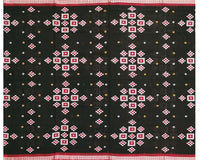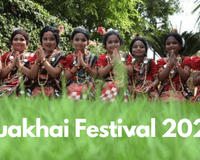
Puri is a coastal district of the Odisha state of India, famous for its historic antiquities, religious sanctuaries, architectural grandeur, seascape beauty, and its moderate climate. It holds a wealth of attractions for visitors. It boasts a continuous history from the 3rd century B.C. to the present, and unique monuments such as those of Lord Jagannath at Puri, and the Sun God at Konark. It has the Chilika Lake, the largest brackish water lakes in India, that holds a picturesque seascape beauty. It offers an ideal resort for birds who migrate from different parts of the continent. By virtue of its geographical location, the climate of Puri is equable throughout the year.
This district comprises 1714 revenue villages. It has one subdivision (Puri Sadar), 11 tehsils and 15 blocks. Puri is the only municipality in the district.
ROAD AND TRANSPORT:-
Earlier, when roads did not exist, people used to walk or travel by animal-drawn vehicles or carriages along beaten tracks to reach Puri. Travel was by riverine craft along the Ganges up to Calcutta, and then on foot or by carriages. It was only during the Maratha rule that the popular Jagannath Sadak (Road) was built around 1790. The East India Company laid the rail track from Calcutta to Puri, which became operational in 1898.Puri is now well-connected by rail, road and air services. A broad gauge railway line of the South Eastern Railways which connects Puri with Calcutta and Khurda is an important railway junction on this route. The rail distance is about 499 kilometres (310 mi) from Calcutta nd 468 kilometres (291 mi) from Vishakhapatnam. Road network includes NH 203 that links the city with Bhubaneswar, the state capital, situated about 60 kilometres (37 mi) away. NH 203 B connects the city with Satapada via Brahmagiri. Marine drive, which is part of NH 203 A, connects Puri with Konark. The nearest airport is the Biju Patnaik International Airport at Bhubaneswar.[Puri railway station is among the top hundred booking stations of the Indian Railways.
CULTURE AND TRADITION:-
Puri is one of the fascinating littoral districts of Odisha. The Cultural heritage of Puri with its long recorded history beginning from third century B.C. till present day, The monuments and religious sanctity, a way of life of the people with their rich tradition possess emphatically to be the cultural heart of Odisha. Indeed Puri is considered cultural capital of Odisha. The culture here is flourished with its manifold activities.
The District has the happy conglomeration of different religions, sects and faith in course of history. The majority of the people are Hindus. The other important communities like Muslims, Sikhs, Jains, Christians and tribals found here in the District. The Hindu monuments of various sectors like Shaivism, Vaishnavism, Sakti cult, Ganapatya, Mahabir etc. are found. Similarly Muslim Mosques, Christian Churches are also noticed here.
Cultural activities, including the annual religious festivals, in Puri, are: The Puri Beach Festival held from 5 to 9 November every year, and the Shreekshetra Utsav held from 20 December to 2 January every year. The cultural programmes include unique sand art, display of local and traditional handicrafts and food festival. In addition, cultural programmes are held for two hours on every second Saturday of the month at the district Collector's Conference Hall near Sea Beach Police Station. Odissi dance, Odissi music and folk dances are part of this event.Odissi dance is the cultural heritage of Puri. This dance form originated in Puri from the dances performed by Devadasis (Maharis) attached to the Jagannatha Temple who performed dances in the Nata mandapa of the temple to please the deities. Though the devadasi practice has been discontinued, the dance form has become modern and classical and is widely popular; many of the Odissi virtuoso artists and gurus (teachers) are from Puri. Some of the famous Odissi dancers are Kelucharan Mohapatra, Mayadhar Raut, Sonal Mansingh, Sanjukta Panigrahi and much more.
Sand art
Sand art is a special art form that is created on the beaches of Puri. The art form is attributed to Balaram Das, a poet who lived in the 14th century. Sculptures of various gods and famous people are now created in the sand by amateur artists. These are temporary in nature as they get washed away by waves. This art form has gained international fame in recent years. One of the famed sand artists of Odisha is Sudarshan Patnaik. He established the Golden Sand Art Institute in 1995, in the open air on the shores of Bay of Bengal, to provide training to students interested in this art form.
Appliqué art
Appliqué art, which is a stitching-based craft unlike embroidery, was pioneered by Hatta Maharana of Pipili. It is widely used in Puri, both for the decoration of the deities and for sale. Maharana's family members are employed as darjis or tailors or sebaks by the Maharaja of Puri. They prepare articles for decorating the deities in the temple for various festivals and religious ceremonies. The appliqué works are brightly coloured and patterned fabric in the form of canopies, umbrellas, drapery, carry bags, flags, coverings of dummy horses and cows, and other household textiles; these are marketed in Puri. The cloth used is made in dark colours of red, black, yellow, green, blue and turquoise blue.
FESTIVALS:-
It is said that 13 festivals are celebrated in the calendar year relating to Lord Jagannath. Some important festivals related to Lord Jagannath and others are listed below.
- Car Festival (Ratha Yatra) in July
- Chandan Yatra in April
- Gosani Yatra, Dasahara in Sept./Oct.
- Sahi Yatra for 7 days from Rama Navami in March/April
- Maha Shivaratri in February in all the Shaiva Pithas
- Magha mela at Konark in January
- Boita Bandan at Konark in Oct./Nov.
- Harirajpur Melan at Harirajpur in March
- Jhamu Yatra at Kakatpur in May
- Dayana chori at Ghorodia in Pipili Block
- Amla Navami at Sakshigopal in March
- Makar Mela at Chilika in January
- Baliharachandi Mela during Raja Festival in June at Brahmagiri
- Anavasara at Alarnatha Mandira, Brahamagiri.
- Siruli Mahavir Mela during Pana Sankranti- Siruli, Sadar Block in April
- Panchudola BALANGA Melan at Balanga Melan field, Nimapara block in March and at Arisandha, Niamapada -specialty in Arisandha GP on this day is Holi plays on this day.
- SNANA PURNIMA celebration of LORD SHREE JAGANNATH and Naga Jatra for three days At RUPADEIPUR,PIPLI BLOCK.
Tourism:-
Jagannath Temple:
The Jagannath Temple in is a famous Hindu temple dedicated to Jagannath (Vishnu) and located in the coastal town of Puri in the state of Odisha, India. The name Jagannath (Lord of the Universe) is a combination of the Sanskrit words Jagat (Universe) and Nath (Lord of). The Jagannath Temple is an important pilgrimage destination for many Hindu traditions, particular worshippers of Krishna and Vishnu, and part of the Char Dham pilgrimages that a Hindu has to be visited in one's lifetime.
Konark Sun Temple:
Konark Sun Temple is a 13th-century Sun Temple (also known as the Black Pagoda) at Konark, in Odisha, India. It was supposedly built by king Narasimhadeva I of Eastern Ganga Dynasty around 1250. It has been built in the shape of a gigantic chariot with elaborately carved stone wheels, pillars and walls. A major part of the structure is now in ruins. The temple is a UNESCO World Heritage Site.
Chandrabhaga :
At about 3 km's from the Sun Temple at Konark is the Chandrabhaga beach. The strong currents do not make it either safe or easy for swimming. But the picturesque view of the sunrise and sunset at this place is enchanting.
For tourists can be availed at Konark, which is just 2km away from Chandrabhaga beach. Hotels in Chandrabhaga are available with all basic amenities.
Sakhigopal :
Sakhigopal, located at distance of nearly 10 to 20 kilometres from Puri, is one of the most famous pilgrimage spots of Odisha. It is an ideal place to get an insight into the Hindu philosophies and learn more about the religion. Sakhigopal is basically famous for the Sakhigopal Temple. This is at the temple dedicated to Lord Krishna. It is one of the oldest temples of Odisha and one of the most famous ones too.
Lokonath :
This is the famous Siva temple of Puri Located about One Kilometre away from the Jagannath Temple towards the western end. There is a popular belief that Lord Ram had installed this lingam with a Lauka or Pumpkin. The Temple was built during 10th-11th century A.D. The devotees come here to see Lord Loknath in order to be cured of any kind of disease. There are certain festivals observed in this temple out of which 'Saranti-Somobar-mela' is the important one.
Harachandi Temple:
Goddess Harachandi temple is at a distance of 25 km's from Puri. It is situated on the side of the sea where the river from Atharnala entered into the sea near Harachandi temple. It is the best place for the picnic. In the side of Harachandi temple, there was only one old route from Puri to Decan via chilika lake. An important health resort of Odisha, the fresh air and exotic landscape of Baliharachandi rejuvenates the tourists with a fresh bout of energy and vigour. The well-known tourist destination of the seaside beach of Baliharachandi is easily accessible by good roads and well laid railway tracks.
Shyamakali :
These shrines are there in the old palace of Gajapati Kings of Puri. Now the historical Royal Palace is situated in the grand trunk road (Bada danda) of Puri. This is a new Place. The old Palace was there in Bali Sahi. From the Southen door of Lord Jagannath temple, one can go to this place.
Gundicha :
The most important sanctuary of Jagannath is the Gundicha temple, the abode to which Jagannath, Balabhadra and Subhadra are driven each of his or her wooden cars once in a year, during the Car Festival. Except for these few days, it is unoccupied, but there is a small establishment of servants by whom it is regularly maintained. It is situated at the other end of the great highway (Badadanda). The distance between the gates of Jagannath temple and the Gundicha temple is exactly 2,688.0696 meters (8327 feet).
Puri Seabeach:
Puri is one of the most popular Orissa beaches that is thronged by the pilgrims all round the year. The shimmering sand, high rising waves and the unbroken seabed of Puri lure national and international tourists. Puri is popular for its temple of Lord Jagannath. The temple was built in the 12th century and dedicated to the Lord of the Universe. Indian and foreign tourists arrive in large numbers every year to seek the blessings of Lord Jagannath, the reigning deity of the region. The pilgrims wade through the waters of the Bay of Bengal and often gather in large numbers in the beaches to take the traditional dip.
Baliharachandi Beach:
Baliharachandi beach of Orissa is situated at a short distance of just 27 km from the famous place of Puri. Salubrious weather, vast stretches of sandy beach and turbulent sea represent the picturesque landscape of Baliharachandi. One of the worth seeing Orissa beaches, Baliharachandi is famous for the revered religious shrine of Goddess Harachandi that draws several devotees from far and wide who visit the holy monument to seek divine blessings and eternal happiness. The seaside beach offers the tourists with a wonderful opportunity to experience the natural splendour of Orissa.
Balighai Beach:
The casuarina-fringed Balighai Beach, located 8 km from Puri, is a famous picnic spot. The juxtaposition of the gentle casuarina-lined river with crashing, desolate ocean coast is a strange and extremely beautiful one. One may also catch a glimpse of the shy Baliharina a kind of deer who inhabit the area. The Sea Turtle Research Center is another attraction of this beach.
Economy:-
The economy of Puri is dependent on tourism to the extent of about 80 percent. The temple is the focal point of the city and provides employment to the people of the town. Agricultural production of rice, ghee, vegetables and so forth of the region meet the large requirements of the temple. Many settlements around the town exclusively cater to the other religious requirements of the temple. The temple administration employs 6,000 men to perform the rituals. The temple also provides economic sustenance to 20,000 people.According to Colleen Taylor Sen an author on food and travel, writing on the food culture of India, the temple kitchen has 400 cooks serving food to as many as 100,000 people. According to J Mohapatra, Director, Ind-Barath Power Infra Ltd (IBPIL), the kitchen is known as "a largest and biggest kitchen of the world.
References:-
1:-https://en.wikipedia.org/wiki/Puri_district
2:-https://en.wikipedia.org/wiki/Puri
3:-http://www.nuaodisha.com/Odisha-Tourism/Tourist-Places-in-Puri.htm







1 comment
Pratap Baliarsingh
I think much more detailed information should be uploaded in the google. No doubt google has done a wonderful job by collecting the information and uploading it a heartfelt of thanks and gratitude to the google manager and all its fellow members, staffs and from small works to the big. But even i was not aware of the small small things but i found it. Its my request if u can upload a detailed of the puri temple, in the sense how did it start, and about siruli mahavir how did it start and it was the lord Hanuman’s will for which a temple had to be built ,and the story related to his tail i think it should be detailed and uploaded. thanks a lot.